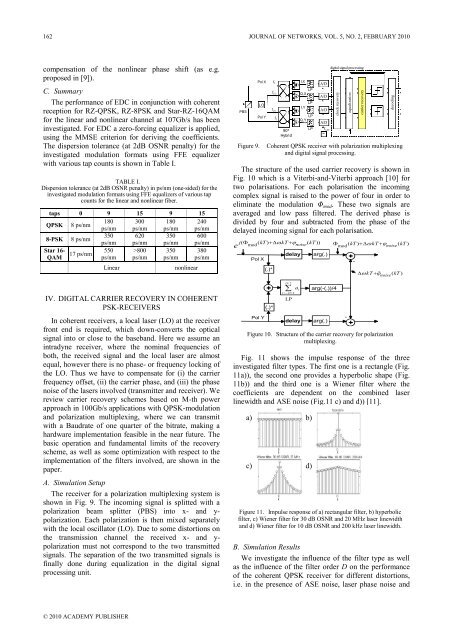Journal of Networks - Academy Publisher
Journal of Networks - Academy Publisher
Journal of Networks - Academy Publisher
You also want an ePaper? Increase the reach of your titles
YUMPU automatically turns print PDFs into web optimized ePapers that Google loves.
162 JOURNAL OF NETWORKS, VOL. 5, NO. 2, FEBRUARY 2010<br />
compensation <strong>of</strong> the nonlinear phase shift (as e.g.<br />
proposed in [9]).<br />
C. Summary<br />
The performance <strong>of</strong> EDC in conjunction with coherent<br />
reception for RZ-QPSK, RZ-8PSK and Star-RZ-16QAM<br />
for the linear and nonlinear channel at 107Gb/s has been<br />
investigated. For EDC a zero-forcing equalizer is applied,<br />
using the MMSE criterion for deriving the coefficients.<br />
The dispersion tolerance (at 2dB OSNR penalty) for the<br />
investigated modulation formats using FFE equalizer<br />
with various tap counts is shown in Table I.<br />
TABLE I.<br />
Dispersion tolerance (at 2dB OSNR penalty) in ps/nm (one-sided) for the<br />
investigated modulation formats using FFE equalizers <strong>of</strong> various tap<br />
counts for the linear and nonlinear fiber.<br />
taps 0 9 15 9 15<br />
QPSK 8 ps/nm<br />
180<br />
ps/nm<br />
300<br />
ps/nm<br />
180<br />
ps/nm<br />
240<br />
ps/nm<br />
8-PSK 8 ps/nm<br />
350<br />
ps/nm<br />
620<br />
ps/nm<br />
350<br />
ps/nm<br />
600<br />
ps/nm<br />
Star 16-<br />
QAM<br />
17 ps/nm<br />
550<br />
ps/nm<br />
>800<br />
ps/nm<br />
350<br />
ps/nm<br />
380<br />
ps/nm<br />
IV. DIGITAL CARRIER RECOVERY IN COHERENT<br />
PSK-RECEIVERS<br />
In coherent receivers, a local laser (LO) at the receiver<br />
front end is required, which down-converts the optical<br />
signal into or close to the baseband. Here we assume an<br />
intradyne receiver, where the nominal frequencies <strong>of</strong><br />
both, the received signal and the local laser are almost<br />
equal, however there is no phase- or frequency locking <strong>of</strong><br />
the LO. Thus we have to compensate for (i) the carrier<br />
frequency <strong>of</strong>fset, (ii) the carrier phase, and (iii) the phase<br />
noise <strong>of</strong> the lasers involved (transmitter and receiver). We<br />
review carrier recovery schemes based on M-th power<br />
approach in 100Gb/s applications with QPSK-modulation<br />
and polarization multiplexing, where we can transmit<br />
with a Baudrate <strong>of</strong> one quarter <strong>of</strong> the bitrate, making a<br />
hardware implementation feasible in the near future. The<br />
basic operation and fundamental limits <strong>of</strong> the recovery<br />
scheme, as well as some optimization with respect to the<br />
implementation <strong>of</strong> the filters involved, are shown in the<br />
paper.<br />
A. Simulation Setup<br />
The receiver for a polarization multiplexing system is<br />
shown in Fig. 9. The incoming signal is splitted with a<br />
polarization beam splitter (PBS) into x- and ypolarization.<br />
Each polarization is then mixed separately<br />
with the local oscillator (LO). Due to some distortions on<br />
the transmission channel the received x- and ypolarization<br />
must not correspond to the two transmitted<br />
signals. The separation <strong>of</strong> the two transmitted signals is<br />
finally done during equalization in the digital signal<br />
processing unit.<br />
© 2010 ACADEMY PUBLISHER<br />
Linear nonlinear<br />
PBS<br />
Pol X<br />
LO<br />
Pol Y<br />
f T<br />
f LO<br />
f LO<br />
f T<br />
90º<br />
Hybrid<br />
I,X<br />
LP<br />
Q,X<br />
LP<br />
I,Y<br />
LP<br />
Q,Y<br />
LP<br />
A/D<br />
A/D<br />
A/D<br />
A/D<br />
~<br />
f ADC<br />
digital signal processing<br />
The structure <strong>of</strong> the used carrier recovery is shown in<br />
Fig. 10 which is a Viterbi-and-Viterbi approach [10] for<br />
two polarisations. For each polarisation the incoming<br />
complex signal is raised to the power <strong>of</strong> four in order to<br />
eliminate the modulation Φmod. These two signals are<br />
averaged and low pass filtered. The derived phase is<br />
divided by four and subtracted from the phase <strong>of</strong> the<br />
delayed incoming signal for each polarisation.<br />
e<br />
Figure 9. Coherent QPSK receiver with polarization multiplexing<br />
and digital signal processing.<br />
j( �<br />
mod<br />
( kT ) ���kT��noise( kT ))<br />
Pol X<br />
Pol Y<br />
(.) 4<br />
(.) 4<br />
delay<br />
D /2<br />
�<br />
i<br />
i��D/2 LP<br />
a<br />
delay<br />
arg(.)<br />
arg(-(.))/4<br />
arg(.)<br />
clock recovery<br />
equalization<br />
carrier recovery<br />
�<br />
mod<br />
( kT ) ���kT��noise( kT )<br />
-<br />
-<br />
��kT�� �noise(<br />
kT )<br />
Figure 10. Structure <strong>of</strong> the carrier recovery for polarization<br />
multiplexing.<br />
Fig. 11 shows the impulse response <strong>of</strong> the three<br />
investigated filter types. The first one is a rectangle (Fig.<br />
11a)), the second one provides a hyperbolic shape (Fig.<br />
11b)) and the third one is a Wiener filter where the<br />
coefficients are dependent on the combined laser<br />
linewidth and ASE noise (Fig.11 c) and d)) [11].<br />
a) b)<br />
c) d)<br />
Figure 11. Impulse response <strong>of</strong> a) rectangular filter, b) hyperbolic<br />
filter, c) Wiener filter for 30 dB OSNR and 20 MHz laser linewidth<br />
and d) Wiener filter for 10 dB OSNR and 200 kHz laser linewidth.<br />
B. Simulation Results<br />
We investigate the influence <strong>of</strong> the filter type as well<br />
as the influence <strong>of</strong> the filter order D on the performance<br />
<strong>of</strong> the coherent QPSK receiver for different distortions,<br />
i.e. in the presence <strong>of</strong> ASE noise, laser phase noise and<br />
decoding

















